Get free scan and check if your device is infected.
Remove it nowTo use full-featured product, you have to purchase a license for Combo Cleaner. Seven days free trial available. Combo Cleaner is owned and operated by RCS LT, the parent company of PCRisk.com.
What is ScanBox?
ScanBox is the name of malware delivered via malicious websites masquerading as legitimate Australian news websites. Cybercriminals behind it target Australian Government agencies, news media organizations, and global energy and manufacturing sectors. Websites used to distribute ScanBox are sent via email.

More about ScanBox
After opening a malicious URL, victims receive a malicious JavaScript code from ScanBox framework. ScanBox can deliver the entire code or separate plugin-based modules. The initial ScanBox JavaScript collects certain information about the victim's browser.
The script gathers the current time, browser language, installed Flash version, the location from which the malicious page is visited, character encoding, screen width and height, and other data. Then it sends harvested information to a Command and Control (C2) server.
After receiving a response from C2, another JavaScript snippet indicates which plugins need to be retrieved and executed in the victim's browser by the main ScanBox script. Plugins (modules) available in the ScanBox framework are the keylogger plugin, browser fingerprint plugin, peer connection plugin, security check plugin, and a plugin that identifies installed browser plugins.
The keylogger plugin records keyboard input (it records all data entered by the victim within the inline frame created by the ScanBox code). The plugin that identifies plugins installed on a browser collects the names and descriptions of legitimate browser plugins in the victim’s browser. The browser fingerprinting plugin harvests further information about the browser.
The peer connection plugin implements a technology allowing Internet browsers and mobile apps to perform real-time communication. The security check plugin checks whether Kaspersky Internet Security is installed on the infected operating system.
| Name | ScanBox exploitation framework |
| Threat Type | Keylogger, spyware. |
| Detection Names | Avast (Other:Malware-gen [Trj]), Combo Cleaner (Trojan.GenericKD.61652272), Emsisoft (Trojan.GenericKD.61652272 (B)), Kaspersky (Trojan.Script.Agent.ii), Microsoft (Trojan:JS/Tnega!MSR), Full List (VirusTotal) |
| Symptoms | There are no clear symptoms (activities visible to victims) suggesting that ScanBox is present and collecting information. |
| Distribution methods | Emails containing links to fake (and malicious) websites. |
| Damage | Stolen sensitive information (e.g., passwords and banking information, ID card information, and social security numbers). |
| Malware Removal (Windows) |
To eliminate possible malware infections, scan your computer with legitimate antivirus software. Our security researchers recommend using Combo Cleaner. Download Combo CleanerTo use full-featured product, you have to purchase a license for Combo Cleaner. 7 days free trial available. Combo Cleaner is owned and operated by RCS LT, the parent company of PCRisk.com. |
ScanBox in general
ScanBox malware collects data that can be useful to cybercriminals for cyber espionage. The keylogging module can obtain various sensitive information (e.g., passwords, credit card details, ID card information, social security numbers, data entered into confidential documents, etc.).
How did ScanBox infiltrate my computer?
Threat actors use email to deliver ScanBox. They send emails containing a link to a fake news website that executes a malicious ScanBox script. That script executes other ScanBox plugins (e.g., a keylogger plugin, fingerprinting plugin). The infection chain starts with opening a malicious URL received via email disguised as a letter from an Australian news media outlet.
How to avoid installation of malware?
Carefully examine suspicious (e.g., irrelevant) emails containing links or attachments. Remember that irrelevant emails sent from unknown addresses (or similar but not the same addresses as the ones belonging to legitimate companies or other entities) can contain malicious attachments or website links. Do not open the contents of emails without being sure it is safe.
Download software (and files) only from legitimate sources. Avoid using P2P networks, unofficial pages, third-party downloaders, and similar sources. Keep the operating system up to date. Never use third-party tools to update (or activate) any software. Use reputable antivirus software for computer protection.
If you believe that your browser is already infected, we recommend running a scan with Combo Cleaner Antivirus for Windows to automatically eliminate infiltrated malware.
Instant automatic malware removal:
Manual threat removal might be a lengthy and complicated process that requires advanced IT skills. Combo Cleaner is a professional automatic malware removal tool that is recommended to get rid of malware. Download it by clicking the button below:
DOWNLOAD Combo CleanerBy downloading any software listed on this website you agree to our Privacy Policy and Terms of Use. To use full-featured product, you have to purchase a license for Combo Cleaner. 7 days free trial available. Combo Cleaner is owned and operated by RCS LT, the parent company of PCRisk.com.
Quick menu:
- What is ScanBox?
- STEP 1. Manual removal of ScanBox malware.
- STEP 2. Check if your computer is clean.
How to remove malware manually?
Manual malware removal is a complicated task - usually it is best to allow antivirus or anti-malware programs to do this automatically. To remove this malware we recommend using Combo Cleaner Antivirus for Windows.
If you wish to remove malware manually, the first step is to identify the name of the malware that you are trying to remove. Here is an example of a suspicious program running on a user's computer:
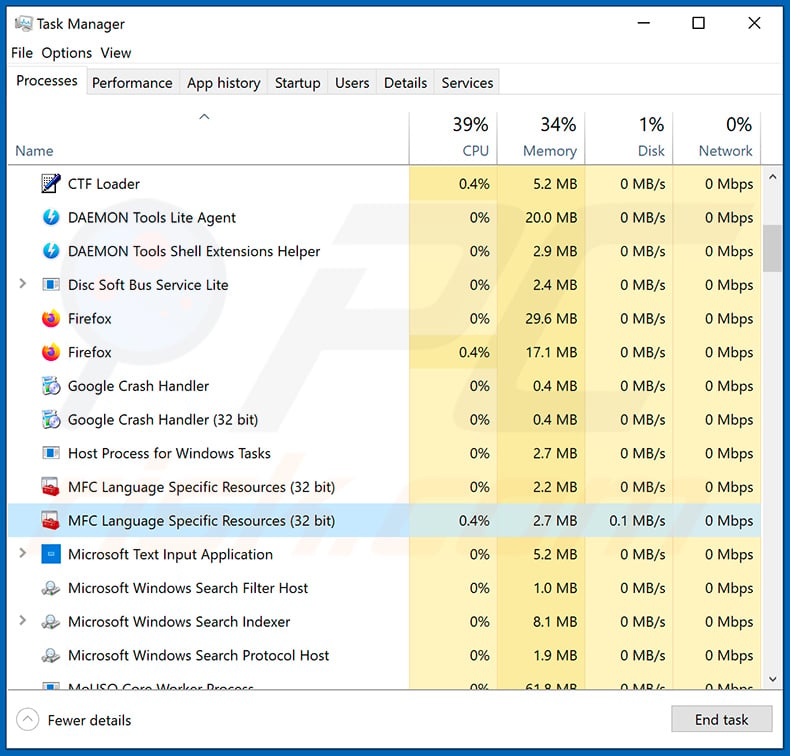
If you checked the list of programs running on your computer, for example, using task manager, and identified a program that looks suspicious, you should continue with these steps:
 Download a program called Autoruns. This program shows auto-start applications, Registry, and file system locations:
Download a program called Autoruns. This program shows auto-start applications, Registry, and file system locations:
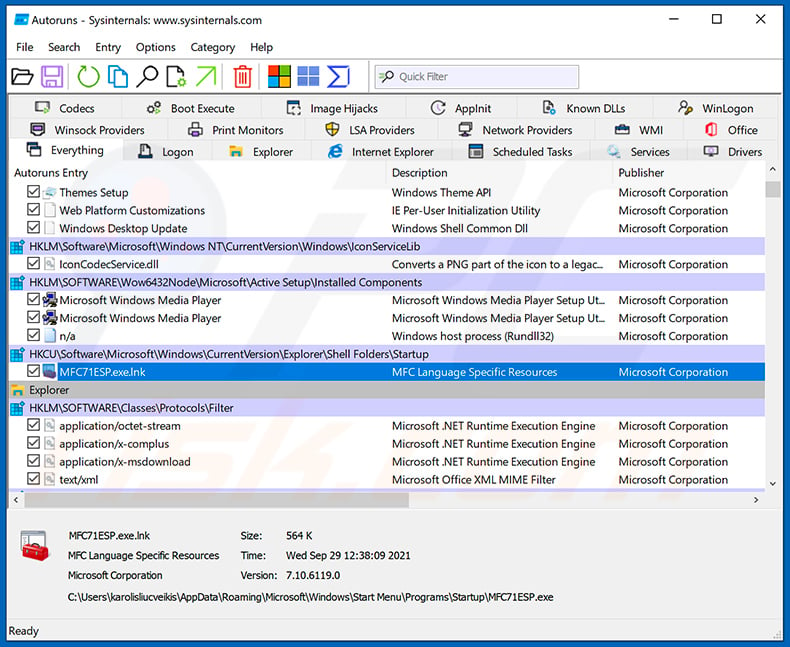
 Restart your computer into Safe Mode:
Restart your computer into Safe Mode:
Windows XP and Windows 7 users: Start your computer in Safe Mode. Click Start, click Shut Down, click Restart, click OK. During your computer start process, press the F8 key on your keyboard multiple times until you see the Windows Advanced Option menu, and then select Safe Mode with Networking from the list.
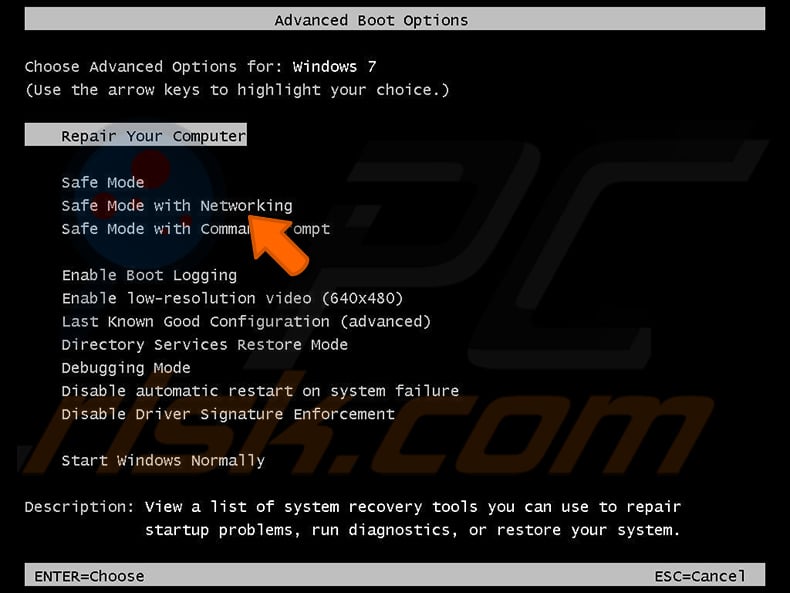
Video showing how to start Windows 7 in "Safe Mode with Networking":
Windows 8 users: Start Windows 8 is Safe Mode with Networking - Go to Windows 8 Start Screen, type Advanced, in the search results select Settings. Click Advanced startup options, in the opened "General PC Settings" window, select Advanced startup.
Click the "Restart now" button. Your computer will now restart into the "Advanced Startup options menu". Click the "Troubleshoot" button, and then click the "Advanced options" button. In the advanced option screen, click "Startup settings".
Click the "Restart" button. Your PC will restart into the Startup Settings screen. Press F5 to boot in Safe Mode with Networking.
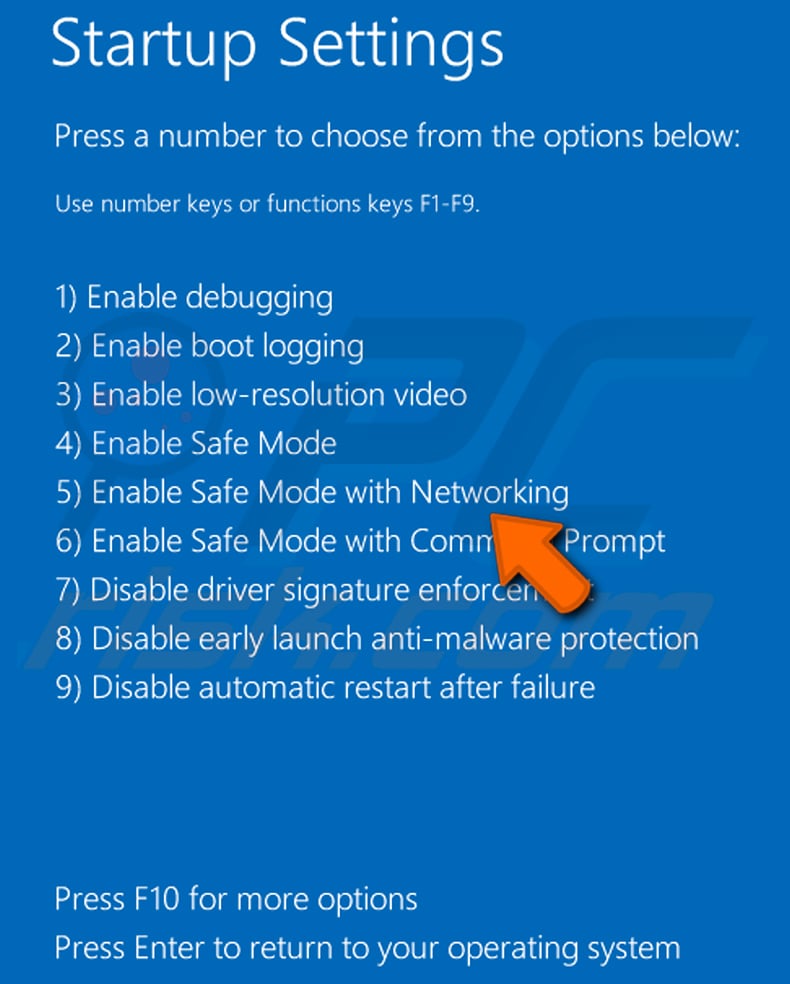
Video showing how to start Windows 8 in "Safe Mode with Networking":
Windows 10 users: Click the Windows logo and select the Power icon. In the opened menu click "Restart" while holding "Shift" button on your keyboard. In the "choose an option" window click on the "Troubleshoot", next select "Advanced options".
In the advanced options menu select "Startup Settings" and click on the "Restart" button. In the following window you should click the "F5" button on your keyboard. This will restart your operating system in safe mode with networking.
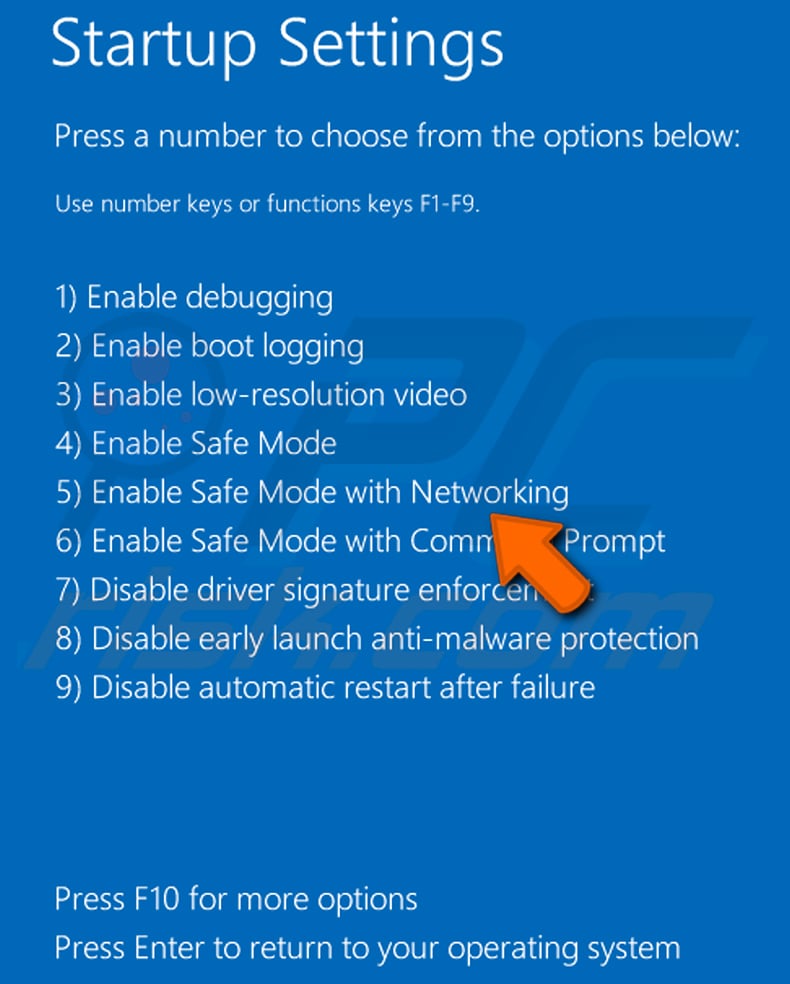
Video showing how to start Windows 10 in "Safe Mode with Networking":
 Extract the downloaded archive and run the Autoruns.exe file.
Extract the downloaded archive and run the Autoruns.exe file.
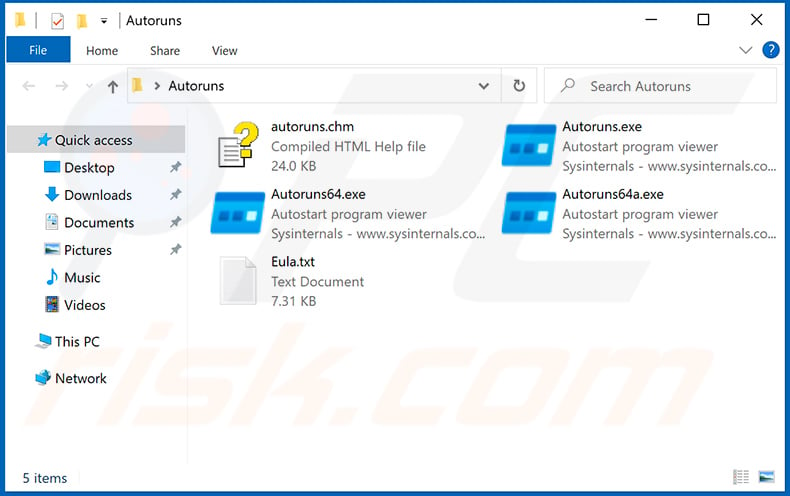
 In the Autoruns application, click "Options" at the top and uncheck "Hide Empty Locations" and "Hide Windows Entries" options. After this procedure, click the "Refresh" icon.
In the Autoruns application, click "Options" at the top and uncheck "Hide Empty Locations" and "Hide Windows Entries" options. After this procedure, click the "Refresh" icon.
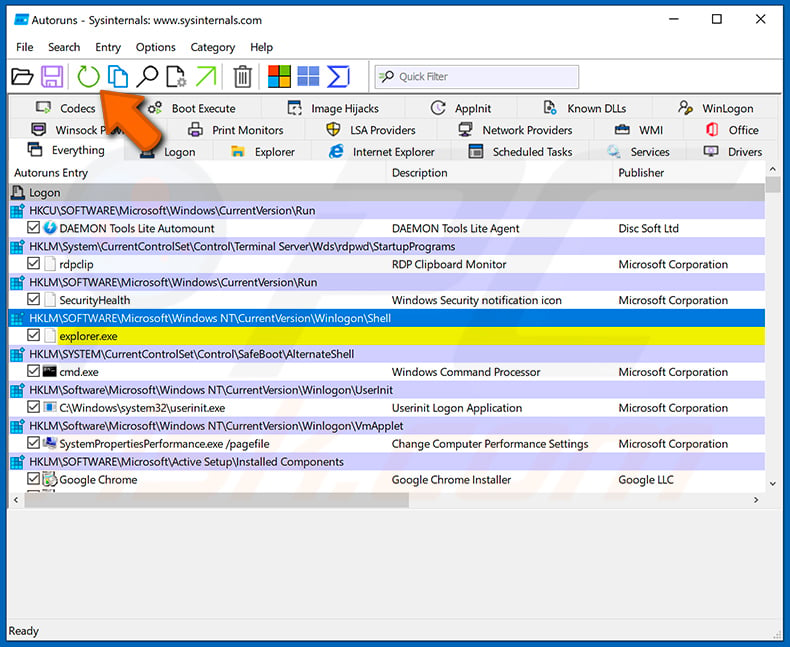
 Check the list provided by the Autoruns application and locate the malware file that you want to eliminate.
Check the list provided by the Autoruns application and locate the malware file that you want to eliminate.
You should write down its full path and name. Note that some malware hides process names under legitimate Windows process names. At this stage, it is very important to avoid removing system files. After you locate the suspicious program you wish to remove, right click your mouse over its name and choose "Delete".
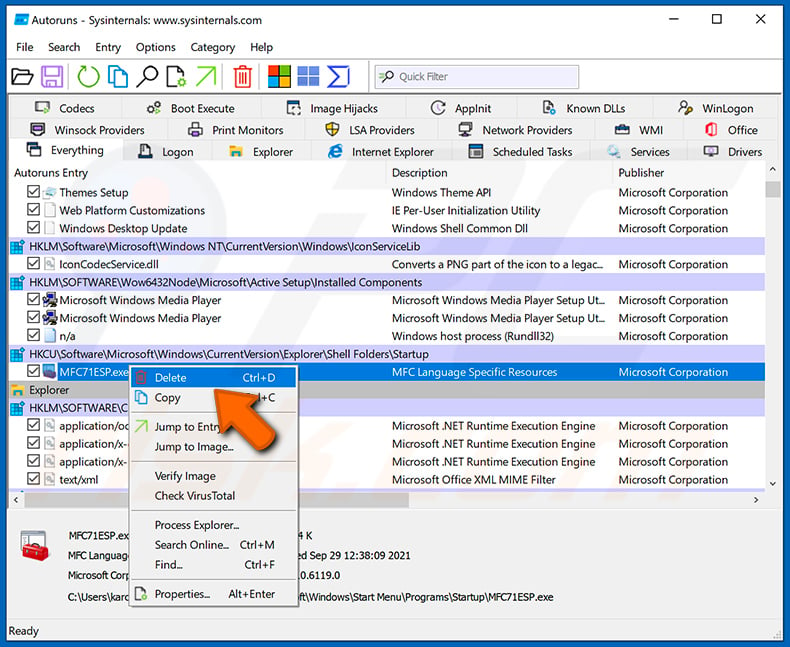
After removing the malware through the Autoruns application (this ensures that the malware will not run automatically on the next system startup), you should search for the malware name on your computer. Be sure to enable hidden files and folders before proceeding. If you find the filename of the malware, be sure to remove it.
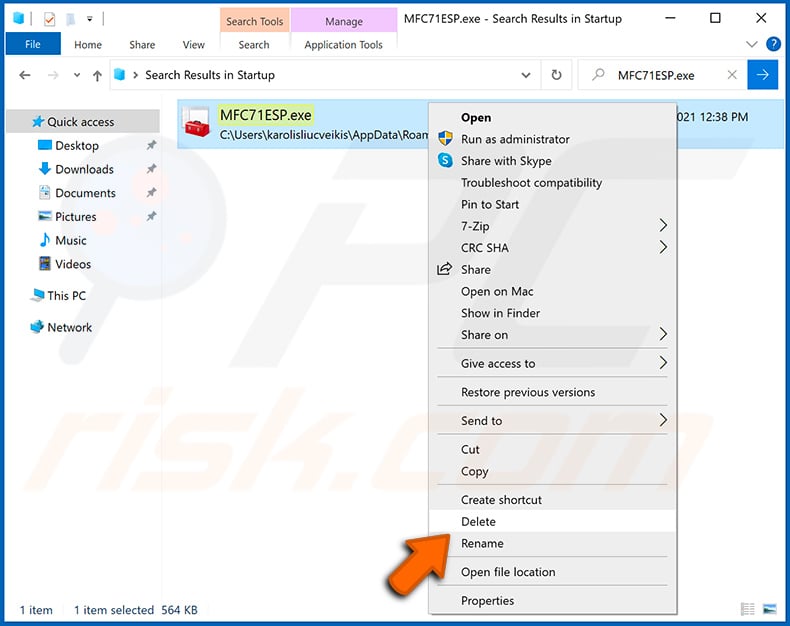
Reboot your computer in normal mode. Following these steps should remove any malware from your computer. Note that manual threat removal requires advanced computer skills. If you do not have these skills, leave malware removal to antivirus and anti-malware programs.
These steps might not work with advanced malware infections. As always it is best to prevent infection than try to remove malware later. To keep your computer safe, install the latest operating system updates and use antivirus software. To be sure your computer is free of malware infections, we recommend scanning it with Combo Cleaner Antivirus for Windows.
Frequently Asked Questions (FAQ)
What are the biggest issues that malware can cause?
Malware can be used to steal money, online accounts, and (or) identities, encrypt files, mine cryptocurrency, launch DDoS and other attacks, and more. It depends on the type of malware (on its capabilities).
What is the purpose of ScanBox malware?
ScanBox gathers information that could be useful to espionage-motivated threat actors. The gathered information includes keystrokes (data entered with the keyboard).
How did ScanBox malware infiltrate my browser?
Cybercriminals deliver ScanBox via email. They send emails containing links to fake/malicious websites designed to execute a malicious ScanBox script that executes its plugins.
Will Combo Cleaner protect me from malware?
Combo Cleaner can detect malware and remove it from the operating system. It is important to know that different kinds of malware have different capabilities. High-end malware can be designed to hide deep in the system. Thus, running a full system scan is required to remove it.
Share:

Tomas Meskauskas
Expert security researcher, professional malware analyst
I am passionate about computer security and technology. I have an experience of over 10 years working in various companies related to computer technical issue solving and Internet security. I have been working as an author and editor for pcrisk.com since 2010. Follow me on Twitter and LinkedIn to stay informed about the latest online security threats.
PCrisk security portal is brought by a company RCS LT.
Joined forces of security researchers help educate computer users about the latest online security threats. More information about the company RCS LT.
Our malware removal guides are free. However, if you want to support us you can send us a donation.
DonatePCrisk security portal is brought by a company RCS LT.
Joined forces of security researchers help educate computer users about the latest online security threats. More information about the company RCS LT.
Our malware removal guides are free. However, if you want to support us you can send us a donation.
Donate
▼ Show Discussion